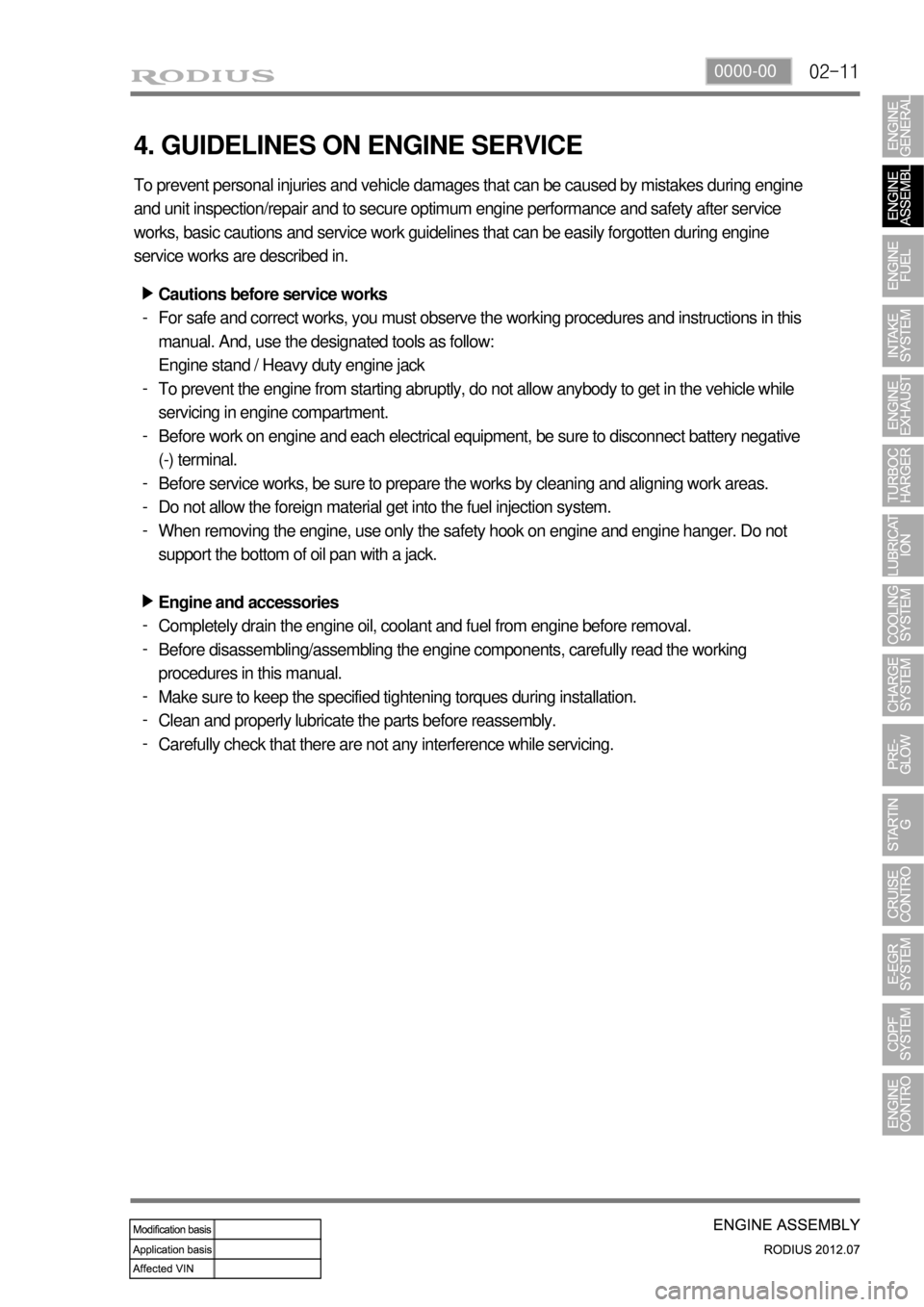Page 168 of 715

02-110000-00
4. GUIDELINES ON ENGINE SERVICE
To prevent personal injuries and vehicle damages that can be caused by mistakes during engine
and unit inspection/repair and to secure optimum engine performance and safety after service
works, basic cautions and service work guidelines that can be easily forgotten during engine
service works are described in.
Cautions before service works
For safe and correct works, you must observe the working procedures and instructions in this
manual. And, use the designated tools as follow:
Engine stand / Heavy duty engine jack
To prevent the engine from starting abruptly, do not allow anybody to get in the vehicle while
servicing in engine compartment.
Before work on engine and each electrical equipment, be sure to disconnect battery negative
(-) terminal.
Before service works, be sure to prepare the works by cleaning and aligning work areas.
Do not allow the foreign material get into the fuel injection system.
When removing the engine, use only the safety hook on engine and engine hanger. Do not
support the bottom of oil pan with a jack.
Engine and accessories
Completely drain the engine oil, coolant and fuel from engine before removal.
Before disassembling/assembling the engine components, carefully read the working
procedures in this manual.
Make sure to keep the specified tightening torques during installation.
Clean and properly lubricate the parts before reassembly.
Carefully check that there are not any interference while servicing. ▶
-
-
-
-
-
-
▶
-
-
-
-
-
Page 169 of 715

02-12
Electrical equipment ▶
Electric devices should be handled more carefully.
Currently, the engine has a lot of electric devices. there could be poor engine performance,
incomplete combustion and other abnormal symptoms due to short circuit or poor contact.
Before work on engine and each electrical equipment, be sure to disconnect battery negative
(-) terminal.
When replacing the electric device, use only genuine part and check the conditions of
connections and grounds. Loosened connection or ground make cause a fire and personal
injury. -
-Fuel and lubrication system ▶
Do not allow the fluid and engine oil to make contact with the body paintwork and hoses.
If work on the fluid system such as fuel and oil, working area should be well ventilated and
smoking should be prohibited.
Gasket or seal on the fuel/lubrication system should be replaced with new ones and bolts and
nuts should be tightened as specified.
After removal/installation works, be sure to check whether there is leak on the connecting
section. -
-
-
-
If fine dust or foreign material enters into DI engine's fuel system, there can be serious damages
in HP pump and injectors. Thus, be sure to plug the inlets of removed fuel line components with
cap and protect removed parts not to be contaminated with dirt. (Refer to cleanness in this
manual while working on DI engine fuel system)
Page 174 of 715
02-170000-00
Vacuum pump
Pump capacity: 210 cc/rev
Camshaft speed:
375 to 3,000 rpm
Lubrication temperature:
-40 to 155°C
Oil: 5W30
Drive type: Driven by exhaust
Camshaft sprocket
EGR cooler bypass valve
This valve is controlled by ECU. When the
engine is cooled, the exhaust gas goes to
combustion chamber without passing through
EGR cooler because the valve is closed by
vacuum pressure.
2. VACUUM PUMP
Vacuum pump generates the vacuum pressure and supplies it to EGR cooler bypass solenoid.
This pump is single vane type and displacement is 210 cc/rev. The lubrication oil is supplied
through the hole in hollow shaft.
Components ▶
Brake booster and naster
cylinder
Page 175 of 715
02-18
1) Location
2) Operation
The vacuum pump is engaged to the exhaust camshaft.
Connection between vacuum pump
and exhaust camshaft
Oil supply and driving
Vacuum pumpExhaust camshaft
Page 179 of 715
02-22
Rear view
5. CYLINDER HEAD COVER AND OIL SEPARATOR
The cylinder head cover is made by high strength plastic to reduce the weight. The multi twist type
oil separator improves the oil consumption.
Components ▶
1) Cylinder Head Cover
Cylinder head cover
Cylinder head cover
Page 180 of 715
02-230000-00
2) Oil Separator
Oil separator separates the particle in blow-by gas to minimize the engine oil consumption and
reduces the inflow oil from intake system into the combustion chamber. The separated oil returns to
oil pan through cylinder head.
Oil separator
Blow-by outlet hose
(1) Overview
(2) Layout
Page 182 of 715
02-250000-00
Location of Expansion Plugs
1) Cylinder Head
(1) Overview
The cylinder is made by gravity casting and the water jacket is integrated type.
The cylinder oil passage is drilled and sealed by cap.
The Camshaft bearing cap is also made by casting and installed on the cylinder head.
(2) Features
Front
Oil gallery expansion plug (M10)
Coolant expansion plug (M21)
Intake side
Rear
Page 183 of 715
02-26
Intake/Exhaust Camshafts
2) Camshaft
(1) Overview
Hollow type camshaft contains cam, octagon cam, HP pump gear and intake/exhaust gears.
Camshaft operates the intake/exhaust valves, vacuum pump and HP pump, and transfers the
engine oil to vacuum pump through the internal oil passage.
(2) Location
Exhaust CamshaftExhaust Camshaft
Thrust journalIntake Camshaft
Closed flow type water jacket (improving cooling performance) ▶
Octagon cam
(for tooling)
Connected to
vacuum pump